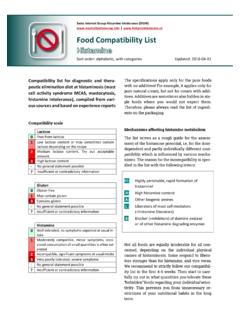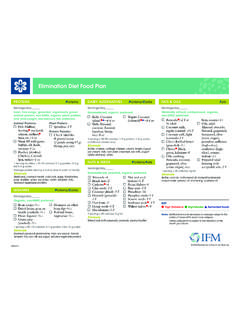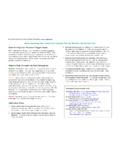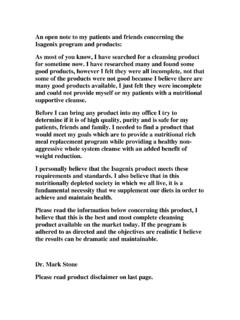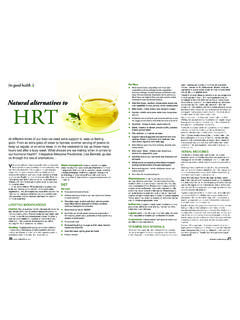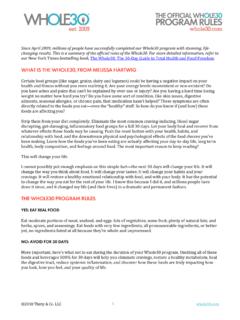Transcription of SIGHI-Leaflet Histamine Elimination Diet
1 Version 2017-07-07 SIGHI-Leaflet Histamine Elimination diet Simplified Histamine Elimination diet for Histamine intolerance (DAO degradation disorder) For people with a DAO degradation disorder who have to avoid Histamine , other biogenic amines and DAO inhibitors. In case of Histamine sensitivity due to mast cell activation disorders (MCAD) this dietary guide-line is not sufficient! If no permanent symptom relief can be achieved and maintained with this diet , please follow the detailed list, which addi-tionally takes Histamine liberators into consid-eration as completely as possible. It is available here: Mast cell activation disorders are often mistaken for Histamine intolerance.
2 The compatibility is highly dependent on the individual sensitivity and the amount con-sumed. Furthermore, it is temporarily affected by stress, hormones and many other factors. First and foremost, the freshness is an im-portant criterion. Everbody has to find out by trial and error what he/she can tolerate in what quantities. In the first line, the diet should be ori-entated to the individual experiences of the per-son concerned instead of strictly following any compatibility list. Always read the list of ingredients to find out whether a food contains incompatible ingredi-ents.
3 References: Experience reports from among our members and readers Various patient leaflets from doctors, clinics and hospitals Experience of other patient organizations, bloggers, forum threads etc. Scientific publications Textbooks and cookbooks about Histamine intolerance To avoid: ? Risky: Well tolerated: General Fermented or microbially ripened products ( alcoholic products, vinegar, yeast, bacteria) Perishable fresh produce with in-adequate / uncertain freshness or interrupted cooling chain. Canned, finished or semi-fin-ished products. Kept warm or reheated food (es-pecially fish, meat and mush-room dishes), products with a long storage time.
4 Meals from res-taurants, can-teens, snack bars, etc. are often badly tolerated for various reasons. Prefer fresh, unprocessed or little pro-cessed basic foods. The more perishable and protein-rich it is, the more important is freshness! It has to be refrigerated uninterruptedly from the producer to the consumer! Perishables never leave unrefriger-ated, not even for a few minutes. Let leftovers cool down for a moment and then freeze. Thaw quickly and consume immediately. Prefer vitamin-preserving methods. To avoid: ? Risky: Well tolerated: Meat, eggs Canned meat, cured, dried, mari-nated, smoked or otherwise pre-served meat (-preparations): dry-cured ham, bacon.
5 Bone-matured or dry aged meat, long hung meat (mainly certain pieces of beef; ask your butcher!) Finely chopped / pureed meat (meatloaf, spreads, cold cuts,..). Histamine content tends to rise with the degree of comminution. Almost all sausages ( salami, liverwurst) Offal, innards (especially liver) Fresh meat sold over the counter (no date on it) Prepacked minced meat Pre-cooked sau-sages Venison, game (ripening of meat) Natural fresh meat (poultry, sheep, goats, cattle, pork, wild boar), as fresh as possible, packaged and dated: cutlet, fillet, chicken legs, turkey breast, .. Frozen meat, thawed rapidly Cooked ham (in slices, without yeast extract or glutamate) Eggs (chicken, quail, etc.)
6 Fish, seafood, crustaceans, shellfish Canned fish, marinated, salted, dried, smoked or pickled fish and seafood. Certain fish species (in particular the Scombroidae family): Tuna, mackerel, herring, sar-dines, anchovies, mahi mahi. Fish sauces Shellfish (mussels, lobsters, crabs, shrimps, prawns) "Fresh Fish" (from the shop shelf, over the counter, from fish markets or in restaurants) . Seafood Absolutely freshly caught fish (anglers, fishermen, fish farm) Frozen fish (No long-time storage. Thaw quickly and use immediately! Do not allow to thaw slowly in the refriger-ator!) pollock, cod, trout, whitefish, perch, organic pangasius Dairy products Matured cheese: hard cheese, semi-hard cheese, soft cheese, processed cheese (also known as prepared cheese, cheese product, plastic cheese), blue cheese, mold cheese, fondue, aged Gouda Raw milk, yogurt, kefir, sour milk products: acidified buttermilk, sour cream, cr me fra che Feta cheese Fresh dairy products: raw milk directly from cow, UHT-milk, pasteurized milk, butter, cream, whey.
7 Cream cheese (mozzarella, curd cheese, cottage cheese, mascarpone, ricotta, goat cream cheese), young Gouda, Butterk se, Schichtk se Cereals, pastry (Possibly yeast and sourdough bakery produce with extra long proving of the dough?) (Possibly very fresh, still almost warm pastries?) Malt, wheat germ Canned corn? Buckwheat un-peeled? Potatoes, corn, rice, any kind of grain in different forms: granules, flakes, semolina, middlings, flour, pasta, bak-ery products, sauces, ..) Vegetables, mushrooms Sauerkraut, spinach, tomatoes (including ketchup, tomato juice, etc.), eggplant, avocado, olives Legumes (lentils, beans, soy, soy products such as tofu) Pickled vegetables Ceps, morels, agaricus Possibly green bush beans, peas?
8 Unfermented olives Mushrooms All vegetables except the left called (fresh or frozen). Fruits, nuts, seeds Strawberries, raspberries, lem-ons, oranges and other citrus fruits, banana, pineapple, kiwi, pears, papaya, guava Nuts (especially walnuts, cash-ews, peanuts, exceptions see right) Avoid overripe fruits and rotten parts. All fruits except the ones listed on the left: apple, peach, apricot, melon, mango, persimmon, lychee, cherries, sour cherries, blackberries, blueber-ries, cranberries, currants, cassis, jos-taberry, fresh, frozen or canned. Coconut, coconut milk, coconut water, macadamias, chestnuts Fats, oils Walnut oil?
9 Vegetable oils, vegetable fats, animal fat, fish oil Spices, hydroly-sated proteins Vinegar (especially wine vinegar, balsamic vinegar) Yeast extract, flavor enhancers (glutamate, sodium glutamate), bouillon, broth Soy sauce, hot spices Table salt, garlic (fresh or powdered), culinary herbs, mild spices. spirit vinegar = distilled white vinegar, apple cider vinegar. Culinary herbs fresh or dried. Binder: starch, cornstarch = corn-flour, potato starch Sweets Cocoa, cocoa mass, brown and dark chocolate, carob White chocolate Sugar, agave syrup, honey, stevia, jams from acceptable fruits. (Sweet is generally unhealthy.) Bevera-ges Alcoholic beverages, soy milk, energy drinks (theobromine), juices and sodas with incompati-ble ingredients, nettle tea Rice milk, oat milk, clear spirits, black tea, coffee, green tea, es-presso Water, herbal teas, rooibos nature, juices and sodas from acceptable in-gredients, almond milk Miscel-laneous Possibly additives according to (c) Copyright by SIGHI To avoid: ?
10 Risky: Well tolerated: Modes of action to the Histamine metabolism of foods and additives It is important to understand what foods affect the Histamine levels in which way. Besides food contain-ing Histamine directly, there are also those that indi-rectly influence the Histamine levels ( Histamine liber-ators, diamine oxidase inhibitors, other biogenic amines and sub-stances that affect the intestinal permeability). A Histamine intoler-ance can have various causes with different underlying pathogenetic mechanisms. This may be one of the reasons why not all those af-fected react equally to the same foods or categories of triggers re-spectively.
